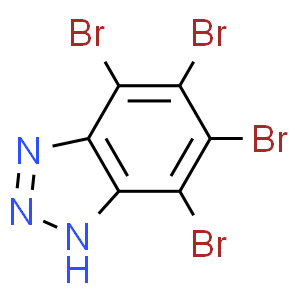| 中文名称: | TBB | ||||
|---|---|---|---|---|---|
| 英文名称: | TBB | ||||
| 别名: | 4,5,6,7-四溴-1H-苯并三唑 NSC 231634; Casein Kinase II Inhibitor I | ||||
| CAS No: | 17374-26-4 | 分子式: | C6HBr4N3 | 分子量: | 434.71 |
| CAS No: | 17374-26-4 | ||||
| 分子式: | C6HBr4N3 | ||||
| 分子量: | 434.71 | ||||
| MDL: | MFCD06411399 | EINEC: | 231634 | ||
| EINEC: | 231634 | ||||
基本信息
|
产品编号:T10774 |
|||||
|
产品名称:TBB |
|||||
|
CAS: |
17374-26-4 |
储存条件 |
粉末 |
2-8℃ |
四年 |
|
|
|
||||
|
分子式: |
溶于液体 |
-80℃ |
两年 |
||
|
分子量 |
434.71 |
-20℃ |
一个月 |
||
|
化学名: |
|||||
|
Solubility (25°C) |
体外 |
DMSO |
86 mg/mL (197.83mM) |
||
|
Ethanol |
|
||||
|
Water |
|
||||
|
体内 |
现配现用 |
|
|||
|
<1mg/ml表示微溶或不溶。 |
|||||
|
普西唐提供的所有化合物浓度为内部测试所得,实际溶液度可能与公布值有所偏差,属于正常的批间细微差异现象。 |
|||||
|
请根据产品在不同溶剂中的溶解度选择合适的溶剂配制储备液;⼀旦配成溶液,请分装保存,避免反复冻融造成的产品失效。 |
|||||
制备储备液
|
浓度
溶液体积 质量 |
1mg |
5mg |
10mg |
|
1mM |
2.3004mL |
11.5019mL |
23.0038mL |
|
5mM |
0.4601mL |
2.3004mL |
4.6008mL |
|
10mM |
0.2300mL |
1.1502mL |
2.3004mL |
|
50mM |
0.0460mL |
0.2300mL |
0.4601mL |
生物活性
|
产品描述 |
一种可渗透细胞,ATP竞争型的 CK2 抑制剂。 |
|
|
靶点/IC50 |
CK2 0.4μM(Ki) |
CK1 47μM(Ki) |
|
体外研究 |
Investigation of the inhibitory power of TBB with a panel of 33 protein kinases shows highest potency for CK2 (casein kinase 2) (human CK2: IC50=1.6μM at 100μM ATP). TBB also inhibits three other kinases with less potency: CDK2 (IC50=15.6μM), phosphorylase kinase (IC50=8.7μM) and glycogen synthase kinase 3β (GSK3β) (IC50=11.2μM). All other kinases tested have IC50 values 50-fold greater than that for CK2. The viability of the androgen insensitive PC-3 cells may be diminished by TBB (60μM TBB) acting either alone or combined with anticancer agents CPT or TRAIL when a proper time schedule of the administration is applied. The time schedule-dependent activity of TBB does not come from its effect on apoptosis in PC-3 cells. TBB is an ATP/GTP competitive inhibitor of protein kinase casein kinase-2 (CK2), has been examined against a panel of 33 protein kinases, either Ser/Thr- or Tyr-specific. In the presence of 10 μM TBB (and 100μM ATP) only CK2 is drastically inhibited (>85%) whereas three kinases (phosphorylase kinase, glycogen synthase kinase 3L and cyclin-dependent kinase 2/cyclin A) underwent moderate inhibition, with IC50 values one-two orders of magnitude higher than CK2 (IC50=0.9μM). TBB also inhibits endogenous CK2 in cultured Jurkat cells. |
|
|
体内研究 |
The extent of retinal neovascularization in a mouse OIR model is reduced by approximately 60% after treatment with TBB (6 days at 60 mg/kg per day). |
|
推荐实验方法(仅供参考)
|
细胞实验: |
|
|
Cell Assay |
PC-3 or HeLa cells are cultured routinely in RPMI-1640 and DMEM media, respectively, which are supplemented with 10% FBS, Penicillin (100 U/mL) and Streptomycin (100μg/mL) at 37°C in a humidified atmosphere of 5% CO2. Cells are seeded at 5×104 cells/well (PC-3) or 2×104 (HeLa) in 24-wells plates and cultured for 72 h. TBB (final concentration 60μM), CPT (final concentration 5.8nM), 2-deoxyglucose (2-DG; final concentration 0.5mM) or TRAIL (final concentration 13.3ng/mL) are added to the medium individually or in a combination and the cells are cultured for additional time, indicated on each figure. After treatment, the medium with the agent is removed and 500μL of MTT mixture (0.5mg/mL for PC-3 and 5.0mg/mL for HeLa cells in medium without phenol red) is added to each well and incubated for an additional 1 h at 37°C. The formazan crystals are diluted in 250μL of DMSO. The absorbance is measured at 570nm. |
|
动物实验: |
|
|
Animal Administration |
Mice The heterozygous C57BL/6J mice are used. Emodin and TBB are injected intraperitoneally in volumes of 50μL or less per mouse at doses of 15 to 30mg/kg body weight, twice daily, starting from day 11. Control mice are injected with PEG-Tween vehicle alone. |
本计算器可帮助您计算出特定溶液中溶质的质量、溶液浓度和体积之间的关系,公式为:
质量 (g) = 浓度 (mol/L) x 体积 (L) x 分子量 (g/mol)
摩尔浓度计算公式
用本工具协助配置特定浓度的溶液,使用的计算公式为:
开始浓度 x 开始体积 = 最终浓度 x 最终体积
稀释公式
稀释公式一般简略地表示为:C1V1 = C2V2 ( 输入 输出 )








